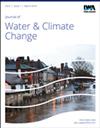Investigating the projected changes in water balance components under climate change considering the effect of storage structures
IF 2.7
4区 环境科学与生态学
Q2 WATER RESOURCES
引用次数: 0
Abstract
The objective of this study was the critical challenge of accurately predicting water balance components in the Upper Bhima River basin, which is also facing significant challenges due to climate change. A major challenge faced in water balance studies is inadequacy of existing hydrological models to account for the effects of storage structures. The study utilized the variable infiltration capacity–routing application for parallel computation of discharge hydrological model with a newly developed storage structure scheme to simulate water balance components for historical (1999–2010) and future (2019–2040) periods, with future climate forcing from 19 CMIP5 GCMs under RCP4.5 and RCP8.5 scenarios. The performance of the model was evaluated against observed streamflow data and around 30% improvement is noticed for the Nash–Sutcliffe efficiency score. The results signify the adverse impacts of climate change in the region, particularly a significant decrease in monsoon precipitation which may intensify drought scenarios and affect monsoon-driven agriculture. Furthermore, the study emphasizes the high sensitivity of baseflow in the Upper Bhima River to climate alterations, indicating potential threats to biodiversity and river ecosystem health. This research offers indispensable findings crucial for future strategies concerning hydropower, flood management, and water resource management in the region.考虑到蓄水结构的影响,研究气候变化下水平衡各组成部分的预测变化
这项研究的目标是准确预测上毕马河流域的水平衡成分,因为该流域也面临着气候变化带来的重大挑战。水量平衡研究面临的一个主要挑战是现有水文模型无法充分考虑蓄水结构的影响。该研究利用可变渗透容量-路径应用并行计算排放水文模型和新开发的蓄水结构方案,模拟历史时期(1999-2010 年)和未来时期(2019-2040 年)的水平衡组成部分,以及 19 个 CMIP5 GCMs 在 RCP4.5 和 RCP8.5 情景下的未来气候强迫。根据观测到的溪流数据对模型的性能进行了评估,发现纳什-苏特克利夫效率得分提高了约 30%。研究结果表明,气候变化对该地区产生了不利影响,尤其是季风降水量的大幅减少可能会加剧干旱情况,影响季风驱动的农业。此外,研究还强调了比马河上游的基流对气候变化的高度敏感性,这表明生物多样性和河流生态系统的健康可能受到威胁。这项研究为该地区未来的水电、洪水管理和水资源管理战略提供了不可或缺的重要发现。
本文章由计算机程序翻译,如有差异,请以英文原文为准。
求助全文
约1分钟内获得全文
求助全文
来源期刊

Journal of Water and Climate Change
WATER RESOURCES-
CiteScore
4.80
自引率
10.70%
发文量
168
审稿时长
>12 weeks
期刊介绍:
Journal of Water and Climate Change publishes refereed research and practitioner papers on all aspects of water science, technology, management and innovation in response to climate change, with emphasis on reduction of energy usage.
 求助内容:
求助内容: 应助结果提醒方式:
应助结果提醒方式:


